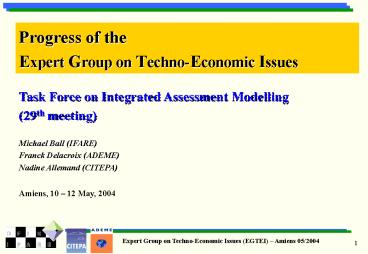Kein Folientitel - PowerPoint PPT Presentation
1 / 23
Title:
Kein Folientitel
Description:
UFC-[MJ/kg] 2030. 2025. 2020. 2015. 2010. 2005. 2000. 1995. 1990. Fuel-Param ... BC1-[%/100] 2010. 2005. 2000. 1995. 1990. Fuel-Param. RAINS. EGTEI. 0.10. 0.13 ... – PowerPoint PPT presentation
Number of Views:19
Avg rating:3.0/5.0
Title: Kein Folientitel
1
Progress of the Expert Group on Techno-Economic
Issues Task Force on Integrated Assessment
Modelling (29th meeting) Michael Ball
(IFARE) Franck Delacroix (ADEME) Nadine Allemand
(CITEPA) Amiens, 10 12 May, 2004
2
Expert Group on Techno-Economic Issues (EGTEI)
Techno-economic data and their validation are
essential for the derivation of consistent and
cost-efficient reduction strategies for air
pollutants and green house gases.
3
Organization of EGTEI
- CITEPA in charge of VOC sectors, mobile sources,
agriculture, wood combustion in small domestic
appliances, - IFARE in charge of SOx, NOx and dust emitting
sectors - ADEME
- Financial and technical support
- Leader of the whole program on behalf of the
French Ministry of the Environment
4
ECODAT (Techno-Economic Database on Reduction of
Air Pollution)
- Offer structured and comprehensive approach,
based on working documents - Increase reliability by homogenously applied
tool (all parties) - Improve transparency including documentation on
origin of data and rules of aggregation - Facilitate data collection and transfer to
IIASA/RAINS
5
What ECODAT provides...
A user-friendly framework facilitating data
collection to define emission reduction
strategies and associated costs
- Reference installations,
- Activity levels,
- Fuel consumptions,
- Fuel characteristics,
- Unabated emission factors,
- Technical options and removal efficiencies,
- Techno-economic parameters of abatement
measures, - Application rates and applicabilities,
- Costs per ton of pollutant abated and per
production unit, - Emission levels for each activity sector
according to different emission reduction
strategies.
Parameters
6
Presentation of ECODAT
7
Outlook Emerging Technologies
- Extension of ECODAT Project Emerging
Technologies IPTS Sevilla
8
EGTEI sectors already covered
- ? Glass
- Cement,
- Lime,
- Refineries,
- Nitric acid,
- Large combustion plants ( ? 500 MWth),
- Small domestic appliances using wood as fuel,
- Distribution of liquid fuels,
- A lot of various VOC sectors (chemical industry,
- solvent uses in industry, in domestic
applications), - Non road mobile sources,
- Costs for on road vehicles (Ricardo study),
- etc...
9
Sectors currently examined in order to be
integrated in the RAINS VOC module
- Steam cracking, PVC production and downstream
units - Tyre production
- Manufacture of paints, inks, and glues
- Decorative paints
- Leather coating
- Industrial uses of glues
- Industrial uses of paints (3 sectors)
- Manufacture of shoes
- Vehicle refinishing
- Emanelled wire coating
- Preservation of wood
- Dry cleaning
- Surface cleaning
- Polystyrene processing
- Specialty organic chemical industry
- Distribution of liquid fuels
- Off-road (costs)
- On-road vehicles (costs) (Ricardo-Study)
10
EGTEI working plan 2004
Sectors to be addressed in more detail
- ? Other combustion plants (e.g. incineration),
- Sulphuric acid,
- Turbines,
- Stationary engines,
- Iron and steel,
- etc...
11
Illustration of EGTEI output - example of the
cement sector
- What is required by the EGTEI approach ?
- The activity level (from 1990 to 2030),
- The energy consumptions (from 1990 to 2030),
- The fuel characteristics (from 1990 to 2030),
- Emission levels concerning SOx, NOx and dust
(from 1990 to 2000).
At this level, no difference with the RAINS
approach except in the hypotheses examined by
France during the consultation phase.
12
Cement sector continued
Specific energy consumption
EGTEI
RAINS
Type of fuels used by the cement sector
RAINS
EGTEI
13
Cement sector continued
- What is provided by the EGTEI approach?
- The technical options, their efficiencies and
their costs, - Pollutants SOx, NOx and dust.
14
Cement sector continued
Example with NOx
EGTEI
RAINS
Unabated emission level in kg/t of cement
Between 1,75 and 3,16 depending on the country
(F 1,85 UK 3,16)
2,57
Technical options
15
Cement sector continued
Example with NOx
Costs
EGTEI
RAINS
16
Cement sector continued
Example with NOx
Emission levels
RAINS
EGTEI
17
Cement sector continued
Example with Dust
BAT associated emission level between 20 and 30
mg/Nm3
RAINS
EGTEI
18
Cement sector continued
Example with Dust
Emission levels
RAINS
EGTEI
19
Illustration of the EGTEI output with other
sectors
- ? Lime,
- ? Nitric acid,
- ? Glass,
- Large combustion plants,
- etc...
20
Conclusions (I)
- Modelling approach often not very well-known by
the technical experts at the beginning of the
program, - Determination of a modelling approach per
sector based on a compromise between simplicity
for national experts and representation of very
complex sectors, - Problems encountered with detailed information
collection - - Lack of statistics concerning installation
characteristics, fuels used, etc.. when
working at the desired disaggregated level, - - Structure of inventories not always adapted,
- - Need of non negligible resources for data
collection. - Involvement of parties could be improved
different priorities of countries towards
importance of sectors, - Cooperation of industry generally good but
dependent on the sector.
21
Conclusions (II)
- Achievements
- EGTEI VOC modules are examined by CIAM for the
adaptation of the RAINS model, - Costs determined for off-road sources taken
into account by CIAM, - For other industry sectors, interest of the
proposed approaches recognized but due to the
lack of input data for all parties EGTEI
approaches not yet integrated in the RAINS
model, - Aggregation routine implemented in ECODAT
22
Outlook The future of EGTEI
- Harmonisation between EGTEI and BREF activities
- (BATs are already integrated in the EGTEI work
and - the EGTEI output could be considered during the
- BREF updating process)
- Increase the level of participation of Parties
- Long-term initiative, permanent task?
23
Thank you very much for your attention
http//citepa.org/forums/egtei/egtei_index.htm































